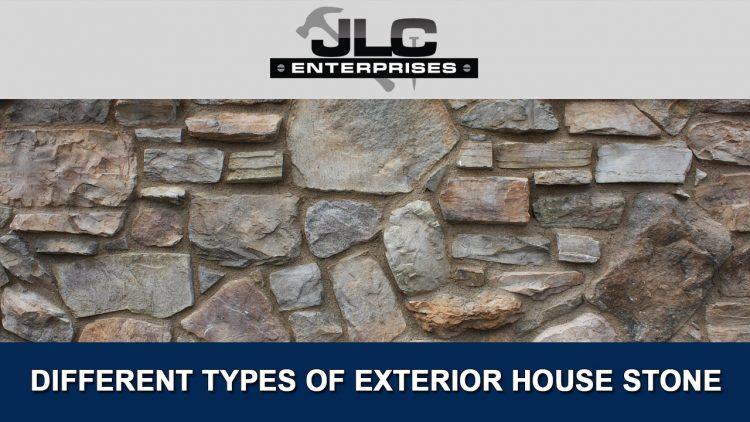Different Types Of Exterior House Stone

If you are wondering what the different types of exterior house stone there are, this post should help! At JLC Enterprises, one of our interests is the concept of transformation. To some people, this may be an obvious aspect as they’ve come to know us. When it comes to transformation, what better method is there than updating or adding to the texture and look of your home’s exterior?
One popular choice among homeowners is stone siding, as it gives the ability of achieving that transformation the property needs between ordinary and extraordinary. However, similar to that of flooring technology, innovation associated with stone effect creation used with exterior and interior walls, fireplaces and other elements have improved greatly over time.
With the improved innovations, this enables various options for stone siding to provide a unique appearance and style that homeowners can only obtain from stone. With this in mind, below are five types of stone siding available, each having distinct advantages.
1. Solid Stone Siding
When it comes to exterior surfacing projects, solid stone siding is a popular choice that has been used for hundreds of years, and offers advantages including authentic appearance and superior durability that only stone can provide. These are significant benefits, which resulted in improving technology for reproducing them. Of course, as with anything there are some drawbacks associated with using solid stone siding, which ignited the innovation behind the technology.
For example, solid stone is much heavier than other materials, requiring more intensive labor for creating the solid stone siding, which is often done by hand. It also needs alternative methods for reducing shipping costs, reducing time for project completion, etc. Fortunately, there are some options for this.
Because manufactured solid stone siding is created using cement, placed within molds and set, the finished product appears similar to that of natural stone patterns. These are installed using a stone-by-stone basis, using mortar to set them, just like real solid stone would be.
2. Manufactured Stone Siding
Any natural stone alternative requires the appearance of looking natural while being durable, but minimizing the negative limitations of the real thing. There are times this is called cultured stone, which is done by manufactured stone and alternatives. It is fabricated using molds which replicates the appearance of real natural stone. Stone siding is manufactured with separate cement ‘stones’ while creating new stone siding types which are installed similarly, but weight much less compared to natural stone, making the cost lower.
Polyurethane foam corner pieces, also known as ‘faux-stone siding’ is installed using larger panels. Therefore, allowing installation to use a straight-forward approach, even though it is not created using real stone.
3. Polyurethane-Based Foam Panel Stone Siding
When needing a real stone alternative that is very lightweight, faux stone panel siding, or foam panel stone siding is a great option. It is created using polyurethane that has been densely rendered. It is designed to appear like stone siding, and installed using panels rather than stone by stone. That makes this stone-like siding a straight-forward installation. There has been amazing innovative technology increasing the options of appearance of this type of siding. When it comes to appearance, only touching the siding will reveal it’s an alternative stone, and not the real deal. It is also weather resistance, making it last longer as well, while keeping its appearance.
4. Natural Stone Cladding
Stone Cladding is another natural stone option available to homeowners. This stone siding variety offers a harvested stone that is cut larger slabs are cut to size. One popular cladding type includes granite slabs, because it offers a natural stone that is very dense, offers various variety and is crack resistant. Because it is resistant to cracks, it helps the lifespan as moisture is unable to easily penetrate the stone and cause it to become susceptible to freeze-thaw cycles. Also, the stone cladding surface often reflects irregular contours, similar to a traditional masonry. However, each piece has a flat backing, while cladding is fixed on a substrate using staggered style patterns similar to laying brick.
5. Stone Veneer Panel Siding
In several ways, this type of stone siding combines all the options above. First, veneer stone siding is developed using real stone. There are various varieties available with the panel system using natural stone veneer siding fabricated for a seamless locking approach, simple to a puzzle.
Therefore, stone veneer panel siding provides you real stone options, the advantages of durability and appearance, along with a simple installation that is quicker and easier, due to the panel system technology. With the appearance, you get the multidimensional texture, a generalized feel of real stone surface, what else could you ask for? If you want a siding that appears like real stone, feels like real stone, and even made from real stone, without the drawbacks of excessive weight, this could be the best option available.
Buildings with stone siding appear to have a history and permanence. Due to these type of products and innovative technology, property owners can obtain these effects fairly easy, and inexpensive compared to just a few years ago.
JLC Offers Stone Siding Installation In Arizona
If you are looking for siding installation services in Arizona, look no further than JLC Enterprises Inc. JLC offers stone siding installation services to the entire Phoenix, Arizona Valley, including, Phoenix, Gilbert, Glendale and more.
